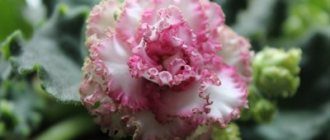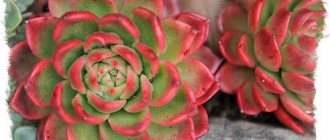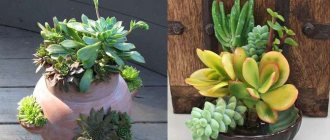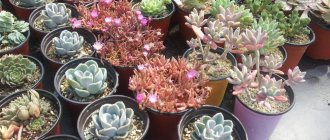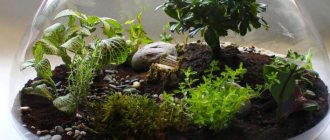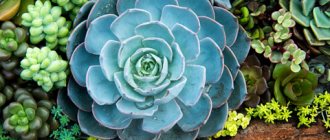The earth's flora is rich and diverse. Among the usual trees, shrubs, and herbs growing in certain natural areas, there are special plants that differ in appearance and method of survival in dry times. This group of evergreen, fleshy, long-lived plants was called succulents, which means they have the ability to store moisture in their tissues. A sufficiently developed shell and a slow evaporation process during the day ensure the preservation of water in the swollen leaves and stems.
Succulents for open ground
All types of succulents have various devices on the surface of their leaves or stems with which they retain moisture. So, according to the method of moisture accumulation, these plants are divided into two varieties. Stem - moisture accumulates inside the stems, thereby causing them to expand and thicken in the form of a ball or bottle. Leafy species accumulate moisture only in the leaves.
Spurge
Euphorbia is native to northern Africa and is widely used as an ornamental and medicinal plant. It contains a specific milky juice that can irritate the skin. The inflorescence has leaf wrappers with a specific yellow-green color. There are species with red and yellow flowers. Plants tolerate both direct sunlight and partial shade. The genus Euphorbia contains about two thousand species, which are represented by perennial herbs and shrubs. Some of them are poisonous.
Euphorbia Mile
Rejuvenated
It is a perennial groundcover plant that is capable of forming an oval and spherical rosette of dense consistency. The leaves of Molodilo are quite fleshy, oblong or ovoid in shape. From the base of the rosette of the plant there are many stolons, which contain daughter rosettes. Peduncles are formed 14-15 cm long with small thyroid-shaped inflorescences of white, pink and red colors. The succulent blooms during June and July, after which the rosette dies off completely. Juvenile is characterized as a cold-resistant and drought-resistant plant that requires sufficient sunlight. Ideal for growing in group compositions or alone in containers and borders in garden beds.
Sedum
A perennial succulent with fleshy leaves and star-shaped flowers, which are collected in umbellate or corymbose inflorescences. Due to its unpretentiousness to the weather and climatic conditions of the growing area, it has become widespread on all continents. The leaves have a flat structure and a cylindrical shape. The arrangement of leaves on the stem is regular. Sepals and petals completely free at the base. Sedum has a very beautiful decorative form. The length of the stamens is twice the length of the petals. There are many species with high winter hardiness, so feel free to plant these succulents in your dacha.
Sedum succulent – Saxifraga
Levisia
A low herbaceous perennial plant. Levisia's leaves are elongated-ovate with wavy edges. The leaves are quite thick and dark green in color. The flowers of the succulent form a few-flowered inflorescence up to 4 cm in diameter. The flower petals are pink or pinkish-lilac with light edges and barely noticeable thin longitudinal stripes.
Bacopa
A sun-loving plant that is unpretentious to the soil. The stems are quite thin with a tendency to lodging. The leaves are very small, ovate and broadly elliptical in shape. The leaf color is green or olive green. The leaf margins have jagged edges. Flowering occurs throughout the summer. The flowers are small, tubular and bell-shaped. The perianth consists of 4 or 5 symmetrical lobes of white, blue or light blue. It is characterized by weak winter hardiness and tolerance to waterlogging of the soil, so such succulents in the country must be prepared for winter. Propagated by cuttings. In summer it is used for landscaping various reservoirs, and in winter it is perfect for use in aquariums.
Ragwort
The ragwort includes various forms: trees, vines, herbaceous plants. The inflorescence of a succulent is a basket that is similar to a dandelion or chamomile. After flowering, flying seeds quickly form in the inflorescence. Raspberry is distinguished by its unpretentiousness in cultivation. Prefers well-lit places and needs several feedings. Propagated by seeds and cuttings. Raspberry plants cannot withstand severe waterlogging of the root layer. Therefore, when growing in the garden, it is worthwhile to carefully choose a place for planting Raspberry.
Meadow cruciferous
Delosperma
This plant is native to southern Africa. In nature, there are more than a hundred species of this plant, which can be ground-covering plants or subshrubs. Very often, delosperma is grown indoors. The above-ground part of the plant is capable of growing strongly in length up to 30 cm. The stems branch quite strongly and bend easily to the ground. The root system of delosperma is highly branched and fleshy in shape. The leaves are lanceolate-shaped, curved, reaching a thickness of 3-4 mm. The aerial part is dark green and bluish. The surface of the green parts very often forms crystals of potassium salts.
Apthenia
The natural condition for the growth of Aptenia is dry subtropics or semi-deserts. On the territory of our country there are four species, low-growing with tetrahedral stems and fleshy leaves. Peduncles form on the tops of the lateral branches and in the axils of the leaves. Aptenia is very demanding of sunlight. The best way to grow a succulent is as a houseplant. In this case, it is necessary to plant in a loose grain mixture with good drainage. Propagated by stem cuttings throughout the spring.
Rejuvenated (stone rose)
Young people are endowed with mystical abilities to ward off evil spirits and neutralize negative energy.
Be that as it may, this plant deserves the attention of novice gardeners due to its unpretentiousness and variety of species.
During the flowering period, a stem covered with leaves grows from the middle of each adult rose. It is crowned with a small but brightly colored flower - the shade depends on the type and variety.
Young Reginae-Amaliae
It is the most rose-like of its species. The succulent leaves-petals have a soft green color, which in the sun can acquire a bright orange edging. Its rosettes are compact and most suitable as the main background plant in a composition of relatives.
Young Brunette
This type is more like a green crystal with a dark red tint. This is a fairly large specimen in its form; it looks great against the background of smaller juveniles and creeping sedums.
Roofing was young
This is the most frost-resistant species, because it has to survive in the conditions of a green roof, where the soil freezes through in winter. Nevertheless, bright green roses with flat petals are a welcome guest both on an alpine hill and in a modular flower garden.
Young Octopodes
It looks like charming balls with dark red petal tips.
When propagating, short branches with miniature balls at the end emerge from under the rosette - these are babies that quickly take root as soon as they land on the ground.
Hybrid youth Fame
It boasts an unusual leaf color. There are soft green, yellow, light pink shades here.
A composition of this species alone is a self-sufficient decoration of a small piece of land, and if you correctly highlight it with monochromatic green relatives, a bright color effect is guaranteed!
Juvenile Soboliferum (runner)
Soboliferum is distinguished by a small diameter rosette and a very dense planting of short leaves.
Caring for succulents in the garden
In order for succulents to reveal their potential and be able to properly decorate the territory of the dacha, it is necessary to carry out a range of measures aimed at creating optimal conditions for the growth and development of these plants. At the same time, ignoring even one factor can lead to a slowdown in plant development or to their complete death.
Location and lighting
When growing succulents in a summer cottage, you need to be very scrupulous in choosing a growing location. Almost all species need sufficient sunlight throughout the day. Even slight shading can cause a decrease in growth activity. Therefore, you should choose a place on a site without nearby tall trees or various buildings. If succulents are grown as indoor plants, they should be placed on south-facing windows or artificial lighting should be used.
What soil is needed for succulents?
Succulents are not demanding on soil fertility. Therefore, they grow normally even on sandy soils. However, it is better to use more fertile soil for planting, as this will avoid several fertilizing and quite frequent loosening of the surface layer.
When choosing a growing location, you should not forget about the acidity of the soil, which has its own optimal indicator for each succulent. In addition to soil fertility, it is necessary to take into account its density. Indeed, in highly compacted soils, the root system develops slowly, which negatively affects the development of the entire plant.
An important soil indicator for succulents is humidity. Due to the fact that succulents do not tolerate prolonged waterlogging of the soil, it is necessary that groundwater does not approach closer than 1.5 m to the surface of the earth. When growing succulents as indoor plants or in containers, it is necessary to have a drainage layer below the soil. Therefore, we can say that succulents prefer soils of average fertility with good drainage ability and optimal soil acidity.
How to water succulents in the country and what to feed them with
Succulents are characterized by high drought resistance. In addition, the plants have a fairly powerful root system that is capable of taking water from the lower soil horizons. Therefore, when you grow succulents in the country, the plant does not need regular watering. Only during a very long dry period can one water-recharging irrigation be carried out per season.
It is advisable to fertilize at least three times per season. But for this it is necessary to use exclusively mineral fertilizers.
The use of organic matter has a negative impact on plant development.
It is best to feed succulents using solutions of liquid fertilizers, such as Vympel (12-14 ml per 10 liters of water) or Energen Aqua (11-13 ml per 10 liters of water). The first feeding is carried out at the beginning of the growing season, and the second before flowering begins. The third feeding is needed by plants in the autumn before going into winter.
Rejuvenated
The stone rose is suitable for beginning flower growers, winning love and recognition for its low maintenance requirements and varietal splendor. The harshest winters (little snow) and the driest periods do not cause much harm to this succulent. Properly selected conditions reduce all the hassle to frequent weeding.
A bright, open place and sandy soil promote completely independent growth. After three or four years, thinning of the plantings is recommended. This will help preserve the original characteristics and avoid shrinking and degeneration of the planted variety. Does not require additional watering.
It is most convenient to place seedlings in the ground. The main plantings take place during the month of July. If necessary, the deadlines are extended into the autumn period. It is important that the plant has time to take root before the onset of cold weather. The most popular representatives:
- Queen Amalia's young (S. reginae-Amaliae). Compact brown rosettes combine very well with their green relatives. Collected in a short panicle, the flowers have pale yellowish tints. Blooms in mid-summer;
- Cobwebby (arachno > Read in detail about growing Juvenile at home and in the garden
Diseases and pests of succulents
The greatest damage to succulents is caused by fungal diseases such as fusarium and late blight. Fusarium affects the roots and gradually affects the entire above-ground part. The main symptom of the disease is stunting of growth and coloration of the plant in a pale gray color. To combat the disease, it is necessary to spray the plants with Fitosporin-M or Fitolavin.
Late blight primarily affects the root collar and subsequently damages the leaves and stems of plants. A sign of plant damage by late blight is the appearance of brown spots. To cure the affected plants, you need to treat the plants with fungicides Ridomil Gold, Horus.
Late blight on succulents
The most harmful pests are aphids and spider mites. Aphids are quickly able to create large colonies, which are located on the lower part of the leaf. These small pests feed on cell sap by sucking the curls of plant leaves. You need to fight aphids using insecticides BI-58N, Karbofos and Metafos.
Spider mites are located, like aphids, on the lower part of the leaf. The mite feeds on plant sap and a growth forms at the site of damage to leaf tissue. If the tick has multiplied greatly, then at the site of its accumulation you can see a white cobweb. To destroy mites, you need to spray plants with the insecticide Karbofos.
Sedum (Sedum)
Succulent cacti: the most unusual succulents types and names
The variety of forms of these, for the most part, perennials is expressed by shrubs, herbaceous specimens or semi-shrub characteristics. The flowering period occurs in the second half of the warm season. Excellent honey plants provide the garden with a sufficient number of pollinators, which are so necessary for many garden and vegetable crops.
All Sedums are drought tolerant, preferring open spaces.
When choosing green “pets” for places with cold winters, you should pay attention to frost-resistant varieties. Guests should plant flower beds before the onset of summer, waiting for the return of possible seasonal frosts. The main concern is the need to frequently weed, which can choke out both young and adult species.
The exception is, perhaps, one Caustic Sedum, which can cope on its own. Watering is carried out only when drought or extreme heat occurs.
The main concern is the need to frequently weed out weeds that can choke out both young and adult species. The exception is, perhaps, one Caustic Sedum, which can cope on its own. Watering is carried out only when drought or extreme heat occurs.
Timely shortening of growing shoots and pruning of faded inflorescences and leaves control the decorative condition. With the onset of stable cooling, all above-ground parts are cut off at a level of up to four centimeters from the soil surface. The resulting “stumps” are awakened by the earth for wintering. Common garden species:
- The bent Cristatum (reflexum 'Cristatum') is known as “Comb”, “Cockscomb”. The varietal feature is expressed by the bright green color of the leaves, reminiscent of needles. Grows into a thick carpet;
- Vidny (S. spectabile) is bred in large quantities with emphasis on leaf and flower color. Looks good in a group combination of different varieties, with conifers. There are quite tall specimens (0.8 meters in height);
- False (spurium) is represented by cleverly intertwined shoots that are capable of rising (more often creeping). Blooms from mid-summer. Star-shaped flowers are collected in corymbose inflorescences. Serve as bright color accents;
- Acrid (acre) is a ground cover plant. The first year, young shoots try to take root in places of contact with the ground. In the second year, during the flowering period, the green foliage is drowned in rich yellow featherbeds;
- Spanish (S. hispanicum) forms a carpet where it grows with a striking bluish tint. Having finished blooming, all shoots die off. Rapid revival occurs by self-seeding.
Read a detailed article about garden species Sedum and their care
Apthenia
The most common throughout the Russian territory is Cordifolia (Ap. cordifolia), another name is Mesembryanthemum cordifolium. Requires sufficient but diffused light content. When placed in open areas, gradual adaptation to direct sunlight is necessary.
The optimal temperature is from 22° to 25 warm degrees. It tolerates wintering without complications. It is advisable to plant individually (rapid development contributes to a negative neighborhood). Its maintenance is minimal. Excess moisture should be avoided.
How does Euphorbia triangular reproduce?
Euphorbia of this species can only be propagated by cuttings; other methods at home are ineffective and are not used. Reproduction is carried out in the spring. For these purposes, young shoots located on the side shoots are cut off (optimal length is 10 cm) and washed under warm running water to remove the juice.
Propagation of crops by cuttings
One cutting is not enough; it is recommended to have a supply of shoots. The cuttings are left to dry and wither for 2-3 days. Crushed charcoal is applied to the cuts. To root the cuttings, they are planted in damp river sand or perlite. The container is placed in a warm and well-lit room, protected from the aggressive effects of the sun. Rooted seedlings are moved to permanent pots.
Levisia
The place for planting should be chosen in partial shade. Direct rays are bad for the health of the plant. It is recommended to cover the root collar with gravel to avoid waterlogging. There are two ways to grow outdoors: sowing seeds before winter (late October) and placing seedlings closer to summer.
Representatives of this vegetation overwinter under the cover of a glass jar, which prevents excess moisture from entering the above-ground parts of the plant during the thaw period. Deciduous specimens tolerate frost without shelter
Care should be taken when watering: water should fall strictly into the root zone, without touching the leaf rosette. During prolonged rainfall, it is necessary to limit moisture by covering the bushes with halves of plastic containers
Blooming Levisia in composition
What it is?
Succulents are a general name for a whole group of plants that may not be related to each other at all, even distant ones. What they have in common is their typical natural habitat and the way these species solved the problem - they grow in desert and arid regions, and are able to accumulate moisture in large quantities in special types of tissue. These tissues often give their trunks and branches their characteristic thick, fleshy shape.
A typical description of succulents from an inexperienced person often also includes such essential features for the plant as the absence of leaves in favor of thorns and the presence of poisonous sap. Such characteristics are indeed inherent in many types of succulents, but in fact they are not mandatory for them. In addition, the presence of one or even several signs characteristic of succulents does not mean that this is a succulent, unless special tissues for accumulating water are observed.
Although succulents are unpretentious in terms of living conditions, this does not mean that they lack natural beauty. Many of these plants in the home garden are valued not only for their ease of care, but also for their vibrant green color, and the flower of many species of the same cacti usually stands out in sharply contrasting tones of red and pink. All this makes a guest from arid countries welcome in our apartments, especially in winter, when you won’t see such bright colors outside.
Fenestraria
Euphorbia (garden species)
A succulent plant from the Aizoonaceae family. The entire genus consists of one plant, Fenestraria aureus. Under natural conditions it grows in Namibia, Africa, and the Karoo Desert. Fenestraria has adapted to the sweltering desert heat in a special way. Its leaves are equipped with specific windows through which light penetrates. It is located at the very top of the leaf, separated by a membrane. It contains a clear liquid. This cunning natural device saves the succulent from overheating and drying out.
Fenestraria forms dense rosettes of cylindrical leaves narrowed to the base. The rosette grows only up to 3 cm in height. In summer it produces a peduncle with a small white or yellow flower. They open in the morning and close in the evening. It blooms in total for about a week.
- This succulent requires a lot of light, but it must be protected from the midday sun. If it is not possible to provide good natural lighting, you need to supplement the plant with special lamps.
- Fenestraria spends the winter rest period at temperatures from +12 to +10 degrees. The rest of the time, room temperature is suitable. Does not require additional air humidification.
- Fenestraria is watered in the summer 2 times a month in a tray. Therefore, the pallet must be high enough. In winter, watering is not required, but if the plant is very dry, you can moisten the soil with a spoon of soft water.
- The soil should be special for succulents and cacti. After purchasing in a store, the plant must be replanted.
Only one species is cultivated: Fenestraria aureus.


